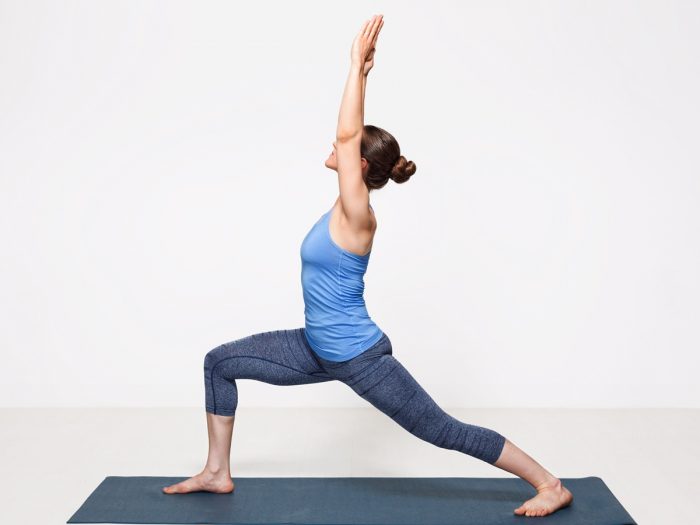15 Best Yoga Poses For Beginners
Countless types of yoga are being practiced all over the world, including plenty of advice for those who are beginners. Some of the best yoga poses for beginners include the plank, triangle, warrior 1, downward-facing dog and bridge.
Moreover, holding those intricate yoga poses in a sweltering room for minutes may seem like torture. Therefore, if you’re a beginner to yoga, or have a child who is interested in learning more about yoga, it is critical to understand this form of exercise , its origins, and some of the best poses for those just entering the world of yoga.
Defining yoga can be difficult without delving too deeply into the spiritual and philosophic side of this personal practice.
Most importantly, yoga is a combination of the mind, body, and spirit, a “union” of sorts, which is what yoga means in Sanskrit. Having originated for more than 5,000 years ago, yoga is a philosophy that has been carried through the millennia and is now practiced by approximately 2 billion people around the world At its core, yoga is about clarifying the mind and attuning the body to the movements of your spirit. There are libraries full of books written about hundreds of different recognized styles of yoga.
However, most people think of yoga as adopting different postures over the course of a yoga session. These postures are known as asanas and are specifically designed to create a dynamic tension and improve the balance within the body. Some of these specific postures have been used around the world for thousands of years and are intended to align the body’s energy flow, detoxify your organ systems and focus on breathing.
Each asana is different and intended to target different parts of the body. These postures can be rotated through quickly, forming a type of “flow”. Also, one can slowly move from one position to the next, focusing on increasing stamina and strength.
There is no right or wrong way to approach yoga, as it is a practice based and driven by personal goals and a rejuvenation of personal philosophy. Furthermore, your “practice” should only include activities that allow you to be comfortable, as any potential benefits will be lost if you are anxious, self-conscious, or straining your body, which can cause inflammation and possible injuries.

However, there are millions of yoga instructors all over the world, trained to educate students and encourage them to adopt the beneficial practice of yoga. Mostly, formal yoga classes last anywhere between 30-60 minutes but advanced courses for yogis may last for hours.
Many people say yoga is addictive, so for any of you beginners out there, open yourself up to the potential benefits this ancient practice can provide.
If you are in your first few months, or even days, of your yoga practice, some of the best yoga poses include the plank, triangle, downward-facing dog, warrior 1 and bridge etc
These are simple poses that are used commonly in most yoga classes, and provide an excellent foundation for more advanced poses as you progress.
Moreover, holding those intricate yoga poses in a sweltering room for minutes may seem like torture. Therefore, if you’re a beginner to yoga, or have a child who is interested in learning more about yoga, it is critical to understand this form of exercise , its origins, and some of the best poses for those just entering the world of yoga.
Basics Of Yoga
Defining yoga can be difficult without delving too deeply into the spiritual and philosophic side of this personal practice.
Most importantly, yoga is a combination of the mind, body, and spirit, a “union” of sorts, which is what yoga means in Sanskrit. Having originated for more than 5,000 years ago, yoga is a philosophy that has been carried through the millennia and is now practiced by approximately 2 billion people around the world At its core, yoga is about clarifying the mind and attuning the body to the movements of your spirit. There are libraries full of books written about hundreds of different recognized styles of yoga.
However, most people think of yoga as adopting different postures over the course of a yoga session. These postures are known as asanas and are specifically designed to create a dynamic tension and improve the balance within the body. Some of these specific postures have been used around the world for thousands of years and are intended to align the body’s energy flow, detoxify your organ systems and focus on breathing.
Each asana is different and intended to target different parts of the body. These postures can be rotated through quickly, forming a type of “flow”. Also, one can slowly move from one position to the next, focusing on increasing stamina and strength.
There is no right or wrong way to approach yoga, as it is a practice based and driven by personal goals and a rejuvenation of personal philosophy. Furthermore, your “practice” should only include activities that allow you to be comfortable, as any potential benefits will be lost if you are anxious, self-conscious, or straining your body, which can cause inflammation and possible injuries.

However, there are millions of yoga instructors all over the world, trained to educate students and encourage them to adopt the beneficial practice of yoga. Mostly, formal yoga classes last anywhere between 30-60 minutes but advanced courses for yogis may last for hours.
Many people say yoga is addictive, so for any of you beginners out there, open yourself up to the potential benefits this ancient practice can provide.
Yoga Poses For Beginners
If you are in your first few months, or even days, of your yoga practice, some of the best yoga poses include the plank, triangle, downward-facing dog, warrior 1 and bridge etc
These are simple poses that are used commonly in most yoga classes, and provide an excellent foundation for more advanced poses as you progress.
Mountain Pose (Tadasana)

This is one of the most basic yoga poses you can do. Many other poses will begin with this one.
Begin by standing with your feet side by side and slightly touching. Clasp your hands at your heart.
Stand tall, and try to lift your shoulders higher to the ceiling. Focus on allowing the energy to course through your body, from your feet to your hands. You can also try this pose with your hands pointing towards the ceiling as well.
Tree Pose (Vriksasana)

Begin in mountain pose (above). Bring your left foot to rest flat on the inside of your right thigh. Your left toes should be just above your right knee.
As in mountain pose, try to focus on standing tall and pointing your shoulder back and towards the ceiling. Clasp your hands at your heart.
If you want to challenge yourself a little more, raise your arms up towards the ceiling. This will make it a little harder to balance, but it will work your muscles more.
3. Cow Pose (Bitilasana)

#3 on our list of basic yoga poses is great for those with back ailments
Cow pose is traditionally performed with cat pose (below) as a “flow” or “vinyasa.” This simply means that the poses are performed together or in a sequence.
Your hands should be shoulder width apart, and your knees should be hip-width apart.
Gaze down at the floor, and arch your back as you exhale. Focus on pushing your butt out behind you.
Cat Pose (Marjaryasana)
From cow pose (above), round your back up towards the ceiling as you inhale.
Repeat cat and cow together with deep breaths for optimal effects. They are counterposes to one another, which means that they move the body in opposite directions. Anytime you put strain on a certain part of your body, you should do a counter pose to release the tensions.
These two poses are great for warming up the back before performing anything more strenuous. They are also great at the end of practice to wind down.
Child’s Pose (Balasana)

Child’s pose is a restorative pose in yoga. Begin in a kneeling position with the tops of your feet flat on the floor.
Sit lightly on your feet but with your heels turned outward just a bit.
Lean forward so that your arms are outstretched on the ground in front of you and your forehead is touching the ground.
This pose can be about resting or meditation. The point is to let the body completely relax.
You should return to this position any time throughout your practice that you feel you need a break or to rest your muscles.
Half Spinal Twist (Ardha Matsyendrāsana)

#6 on our list of basic yoga poses is a twist and is great for your spine.
This is especially important if you do a lot of work on your back in yoga, are on your feet all day, or if you sit hunched over your computer all day
Both knees should be bent, with your right knee bent above the left leg. Reach behind you with your right arm, and use your left elbow to steady yourself on your right knee.
Gently twist until it feels right on your body. Don’t push yourself too far. Hold for 5-6 breaths, and make sure to repeat on the other side.
Lotus Pose (Padmasana)

This pose is often performed during meditation. Don’t let it fool you though.
Beginners should only hold it for a few seconds because it can put a lot of strain on the knees if your body is not used to it.
Begin by bending the knee and placing the top of your left foot just inside the point where your hip creases near the groin. Bend your right knee, and gently lift your right foot on top of the left leg to rest just inside the point where your other hip creases near the groin.
You should feel this in your ankles and your knees. Hold for 5-6 deep breaths, and repeat on the other side.
Hero Pose (Virasana)

#8 on the list of basic yoga poses is great for meditation and posture.
Sit with your knees bent and your feet on either side of your hips with the heels pointed towards the ceiling.
If this pose puts too much strain on your knees, you can sit on a yoga block or a blanket to ease the discomfort until you gain the flexibility to sit on the ground.
If this feels very easy for you, try working towards reclining hero pose by first leaning back on your forearms and then eventually laying all the way down on your back.
Check out these most effective exercises:- Hate Exercising But Need To Burn Of Some Calories? Here's Some Easy Ways
Check out these most effective exercises:- Hate Exercising But Need To Burn Of Some Calories? Here's Some Easy Ways
Warrior I (Virabhadrasana I)
This pose is similar to a basic lunge, except that your outstretched foot should be pointed out to the side rather than tucked under or supported on your toes.
Make sure to keep the bent knee at a 90-degree angle. Your gaze should be straight ahead of you or slightly upward.
Focus on channeling your energy through the hands and towards the ceiling.
Hold for 30 seconds, and repeat on the other side or transition straight into warrior II (below).
Warrior II (Virabhadrasana II)
Warrior I and II are often performed as a vinyasa, along with warrior III, which is a little more advanced and therefore not included in this article.
From Warrior I, bring your arms down and straight out to either side of you as you open your hips and twist your body to face the side.
Warrior I and II will help open the hips and strengthen the quadriceps.
Downward Facing Dog (Adho Mukha Svanasana)
What most people don’t realize when trying to do this pose is that your back should be straight. Try it in front of a mirror, and see if the small of your back is rounded or completely flat. This requires a lot of flexibility in the legs and the back.
Make sure your hands and feet are shoulder width and hip-width apart. Ground into your heels, and get them as close to the mat as possible. This requires flexibility in the ankles.
You can also increase the stretch in your shoulders by leaning your head and chest in towards the ground.
This is one of the most popular poses on the list of basic yoga poses.
Hold for 30 seconds, and try one-legged downward facing dog (below).
Cobra Pose (Bhujangasana)
Cobra pose and upward facing dog (below) are both great stretches for the back.
In cobra, the lower half of your body and even lower ribs should be on the ground, with the tops of your feet touching the ground.
Bend the elbows slightly, and lift the chest. Gaze upward, and keep the shoulders back. This is an intense stretch in the lower back.
Hold for 5-6 breaths. Do a counter pose such as child’s pose after stretching the back.
Plank Pose (Phalakasana)

Yes, the plank is popular in yoga as well! It really is the ultimate position for control in the core.
Place your hands shoulder-width apart, and keep your butt lifted.
In yoga, plank is also often done with the upper back and shoulders rounded, because it is necessary for many transitions into advanced yoga poses. Imagine that someone has a rope around your abdomen and is pulling it up towards the ceiling but you are trying to stay grounded.
Focus on that tightening in the abdomen to keep the core engaged.
Hold for 30 seconds up to 2 minutes.
Lunge (Anjaneyasana)
#14 on the list of basic yoga poses is the basic lunge, and it’s an incredible hip opener!
This is another great pose if you have tight hips or sit behind a computer all day long.
Make sure the knee in front of you is at a 90-degree angle. You can lean forward or sit up straight to stretch different parts of the muscle.
The outstretched knee behind you should be resting on the floor.
This is another two-sided stretch, so make sure to repeat it on the other side. Hold for 5-6 breaths or up to 30 seconds.
Corpse Pose (Shavasana)

The irony in corpse pose is that it is actually much harder than it looks. Many people tend to skip the relaxation part of yoga. This is a mistake because it is actually what lowers your cortisol levels and helps you burn more fat.
It is often hard for many people to “sit still” and relax at any point in their day. You should use this time to let go of negative feelings and energy and let the body completely relax.
It’s often good to do at the end of practice when you’re finished with your routine and/or before meditation.
















Comments
Post a Comment